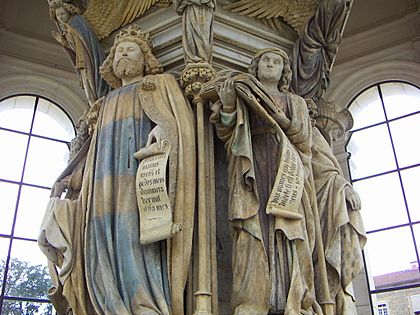Claus Sluter facts for kids

Claus Sluter (born in the 1340s in Haarlem, died 1405 or 1406 in Dijon) was a very important sculptor from the Netherlands. He moved to the Duchy of Burgundy (part of modern-day France) around 1380. He is known as one of the most important sculptors of his time in northern Europe. Sluter helped start a new art style called "northern realism," which focused on making art look very lifelike. This style later became famous with painters like Jan van Eyck.
Contents
Life of Claus Sluter
Claus Sluter's name, "Claes de Slutere van Herlam," is found in the records of stonemasons and sculptors in Brussels around 1379 or 1380. This shows he was already a recognized craftsman.
He then moved to Dijon, which was the main city of Burgundy. From 1385 to 1389, he worked as an assistant to Jean de Marville. Marville was the official sculptor for Philip the Bold, who was the powerful Duke of Burgundy.
After Marville's death, Sluter took over his position in 1389. He became the Duke's main court sculptor and held this important job until he died. His nephew, Claus de Werve, continued his work after him.
Famous Works by Sluter
Claus Sluter created several important sculptures that show his unique realistic style.
The Well of Moses
Sluter's most famous work is called the Well of Moses (made between 1395 and 1403). It was also known as the Great Cross. This large sculpture was made for the Carthusian monastery of Champmol. Duke Philip the Bold founded this monastery just outside Dijon in 1383.
Originally, the top part of the monument had a large cross with a sculpture of Christ. It might have also included figures of the Virgin Mary and John the Evangelist, or possibly Mary Magdalene kneeling. Sadly, the cross and the upper parts were destroyed sometime between 1736 and 1789. This probably happened because the roof of the building protecting it collapsed.
Today, you can still see the base of the Well of Moses. Around this base are six life-sized statues of important figures from the Old Testament. These include Moses, David, Daniel, Jeremiah, Zachariah, and Isaiah. Each figure holds scrolls or books with writings that were seen in the Middle Ages as hints about Christ's sacrifice. The way these Old Testament figures support the cross above them showed how the old stories connected to the new Christian beliefs. The entire monument is made from limestone.
Champmol Portal
A few steps from the Well of Moses is the entrance (or portal) of the former chapel at Champmol. Sluter also created the sculptures for this portal.
- In the middle, there is a standing statue of the Madonna and Child.
- On the left side, you can see a sculpture of Duke Philip the Bold with his patron saint, Saint John.
- On the right side, there is a statue of the Duchess (Philip's wife) with her patron saint, Saint Catherine.
Tombs of the Dukes
Sluter also worked on the main part of Duke Philip's tomb. This tomb has been restored and moved to the Museum of Fine Arts in Dijon, which is located in the old ducal palace.
He also helped create the famous "pleurants" (meaning "mourners" in French). These are small, detailed statues of people grieving. They are placed in niches (small alcoves) around the tombs of Philip the Bold, his wife Margaret, and his son John the Fearless. These mourners add a very emotional and realistic touch to the tombs.
See also
 In Spanish: Claus Sluter para niños
In Spanish: Claus Sluter para niños


